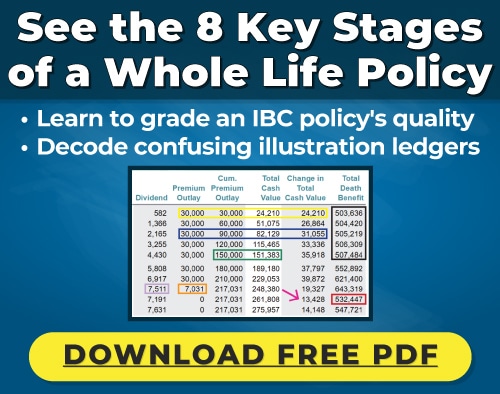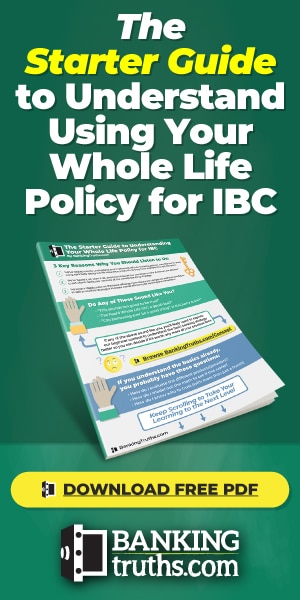Whole Life 4 Kids?
Is Whole Life insurance better for children or their parents when using whole life insurance for infinite banking or tax-free retirement income? This video takes an in-depth look at a juvenile whole life policy and compares it to a similar policy on the parents. The results are shocking!
Video Script:
0:06 – Myths re whole life policies for children and then the truth about whole life for kids
1:27 – The parameters of the 3 whole life policies on the family we’ll be comparing
2:09 – Graphing the first 15 years of the daughter, mother, and father whole life policies
3:44 – Challenges behind children qualifying for a reasonable sized whole life policy
4:27 – Looking 40-years later to see the impact on cash value and death benefit
7:26 – Drilling deep into early cash values (spoiler: the kid’s whole life policy loses)
8:49 – The most important reason you should get whole life for children after parents
Hi, this is Hutch with bankingtruths.com and today we’re gonna explore a whole life for kids or their parents.
There’s a lot of myths surrounding this entire whole life kid policy phenomenon. And it’s mainly dealing with the fact that people think policies on younger insureds automatically equal lower internal insurance costs, therefore giving the better cash value performance, resulting in more net wealth for the family.
And the truth of the matter is, when you get whole life policies on these juvenile insureds, you actually need substantially more death benefit to avoid MEC. So one of the ways they test for a MEC is the seven-pay test. And all that is, is a present value of all the future premiums stuffed into the first seven years.
And so needless to say, if we compare the same premiums on a parent and a kid (which we’re going to do later in this video), that kid is going to need a lot more death benefit to support the same premiums.
The Top 4 Myths Behind Becoming Your Own Banker (Article)
The Simple Science Behind The Banking Concept (Video)
4 Ways Whole Life Insurance Can Help Your Retirement (Article)
Whole Life’s Riders And Growth Components Explained (Video)
Detailed Banking Case Study Using Whole Life (Video)
Best Whole Life Insurance Policy for Banking & Why (Article)
The Top 4 Myths Behind Becoming Your Own Banker (Article)
The Simple Science Behind The Banking Concept (Video)
4 Ways Whole Life Insurance Can Help Your Retirement (Article)
Whole Life’s Riders And Growth Components Explained (Video)
Detailed Banking Case Study Using Whole Life (Video)
Best Whole Life Insurance Policy for Banking & Why (Article)
Now, that does result in worse early cash value performance. And it takes quite a while to catch up. There is better long term performance on these kid policies, but even that is eroded by the fact that there’s no parental death benefit. And so the parents will need some term, which would erode some of that net wealth to the family. There’s also two other major benefits to this parental death benefit, if it’s in the form of whole life, which we’re going to explore later in this video.
So the comparison we’re going to look at goes like this, we’re going to look at a father, a mother and a daughter – all of them are going to have their own unique minimum non-MEC death benefits solve. So because they have different ratings, and they’re different ages, the amount of death benefit needed for each one will be different.
We’re going to put in the same $15,000 of premium for seven years, then we’re going to do a reduced paid up on all seven, so that they’re all operating at optimal efficiency. So let’s take a look.
To get the most out of this analysis, I’m using Ensights policy visualization software, it’s really cool software that allows me to upload the data and show it to my clients in a visual way. So what we’re looking at here is actually the death benefit amounts. In blue is the policy on the daughter, in green is the policy on the mom, and in orange is the policy on the dad.
And as you would expect, the daughter starts with the most amount of death benefit, it’s almost triple what the Father has – it’s a lot more. And so you would think that the cash value would be a lot better. But if I switch to show you what the cash value is, in the first 15 years, you could hardly tell the difference.
And if I just remove the dad for a second, what you’ll see is that blue line is under the green line, which means that there is more cash value on the mom almost this entire time. We get to year 15, Mom’s got $180,000 in her policy versus only $176,000 on the daughter.
Now, Dad has a little bit less, but it takes all the way to year 15 to have a little bit less, and how much term premium would he have saved that he could have invested in his highest rate of return, because you’re kind of like playing with house money at that point? How much money would he have, because he would have this additional death benefit.
Now we’re not talking about a lot in year one at $378,000. It grows with paid up additions to be $600,000. And then after doing that reduced paid up, we drop it back to $329,000. Notice it’s more than what we started with. And then after that those paid up additions still kick in, and it continues to grow.
But I wanted you guys to see that because that misconception that for some reason, the cost will be so much lower. And it makes sense intuitively. But once you understand that the IRS is going to make the daughter have so much more death benefit, all of a sudden you realize that you know what things are pretty equal. They’re pretty close any way you slice them, if I get rid of Momhere, I mean, that’s the blue in the in the orange overlapped. So I want you to know that it’s not that much better.
If you’re neglecting getting a policy on yourself, which by the way is a lot easier to get when you’re asking for a million something dollars of death benefit on a kid. The carrier’s like, “Oh, wait a second, are we going to show up on dateline?” and they actually make you a lot of times have almost double or at least some amount as much or more than what the kids getting.
Now if I fast forward this whole analysis 40 years instead of 15 years, what you can see is the daughter has substantially more cash value. She’s got $770,000 versus the mom has $691,000 and the dad has $640,000. Some of you are saying, “See I told you so that’s what we want. We want what’s best for our daughter.” But you have to remember that by then, the mom is age 86 the dad is age 87 and the daughter is age 56.
But there’s something to remember – you borrow against the cash value for a dynamic retirement buffer, but it’s also a loan against the death benefit, and the death benefit will be more. So remember, the daughter has $770,000 in cash value. If we look at 40 years from now, notice that the dad has almost $770,000 of death benefit.
Now remember, he didn’t pay as much term premiums, so he could have invested that money in what got him the highest rate of return, because that was like finding money on the street, not paying for term insurance. The mom on the other hand, notice she’s got an additional $104,000 of death benefit that would pour in for the daughter and her retirement at age 56.
People forget about that. They just think cash on cash. But you have to remember that there is an opportunity cost by not using life insurance, where you get the highest rate of return. And that’s on the death benefit.
And when you use life insurance as your own bank, and when you use life insurance as a dynamic retirement vehicle, where instead of just bleeding it down just year after year, you use it when tax rates are high, you use it when the markets down. And then if possible, when tax rates are low and the markets up, you take some money out of your retirement accounts, and you make the golden goose hole again, at least patch up some of the wounds from taking the earlier distributions. And if you do that, you’re simply borrowing against the death benefit.
So the daughter would be better off in this case had she waited for the death benefit rather than have her own policy. Now, I’m not saying don’t get a policy on your daughter. But it’s kind of like what the stewardess says when you get on an airplane, put your own mask on first, then help your children because that’s how you’re going to be of the most value. And that’s especially true in the context of whole life, you have to remember that this particular policy also has a free chronic illness writer. And so people are much more likely to become too sick or hurt to handle all their daily needs than they are to pass away. And that could happen a lot sooner.
If we back this up, like let’s say this happened 33 years from now, so in early 70s, well, mom’s got $715,000 a death benefit, dad’s got $622,000, how much cash value? The daughter’s only got $512,000 of cash value.
So if we’re talking about net wealth to the family, it’s a different way to look at it. Now I also know my clients are often very concerned about near term cash values as well. So I really wanted to unbundle this using the spreadsheet view of Ensight software where I can trim out a bunch of unnecessary columns and focus on what’s important.
So over on the left is the daughter, in the middle is the mother, and on the right is the father. And what I want you to see is I just staggered it by every five years starting with year two. And year two, the daughter has the most cash value, but by a very minute amount.
Notice by year seven, once you’ve gotten the full $15,000 of premium in the full $405,000, the daughter has substantially less than the mother and a little bit less even than the father by year 12 similar story – by year 17. Well, she’s outrun dad, but it took 17 years.
So if you’re looking about having maximum capacity early, remember that’s less term you had to buy on the parents. Plus, you’re actually ahead most of the time. And if you look at mom in year 17 she’s still ahead, it takes to year I’m not sure exactly the year. Let’s say year 22, the daughter is still $3 behind mom in year 22.
So before you go running out thinking the best way to get this whole life is just a put it on my kids, definitely run the numbers on yourself. Our team is happy to do that for you and help you build a family portfolio of insurance again to use as your own private bank. Help use for college funding. Help use for dynamic retirement vehicles.
And that’s what we’re going to show in the next video, we’re actually going to take a deep dive into how the entire life cycle of a whole life policy when doing them on kids, I think it’s a great thing to do. Again, once you’ve put the mask on for yourself, your spouse, because let’s face it, if one of you were to go away, you couldn’t be of much help. If we just look at year two, there’s a $15,000 premium due and the daughter’s got $25,000 of cash value in her policy to borrow against and keep paying the premiums let’s say that the breadwinner died.
But had we set it up on mom or dad there’ll be $484,000 of death benefit or $415,000 of death benefit. Less than $30, you paid you’re in a much better spot family wise. So look out for the next video and if you’re ready to look at your own numbers, definitely click this link below and we’ll help you model this for your family.

John “Hutch” Hutchinson, ChFC®, CLU®, AEP®, EA
Founder of BankingTruths.com
The Top 4 Myths Behind Becoming Your Own Banker (Article)
The Simple Science Behind The Banking Concept (Video)
4 Ways Whole Life Insurance Can Help Your Retirement (Article)
Whole Life’s Riders And Growth Components Explained (Video)
Detailed Banking Case Study Using Whole Life (Video)
Best Whole Life Insurance Policy for Banking & Why (Article)
The Top 4 Myths Behind Becoming Your Own Banker (Article)
The Simple Science Behind The Banking Concept (Video)
4 Ways Whole Life Insurance Can Help Your Retirement (Article)
Whole Life’s Riders And Growth Components Explained (Video)
Detailed Banking Case Study Using Whole Life (Video)
Best Whole Life Insurance Policy for Banking & Why (Article)


